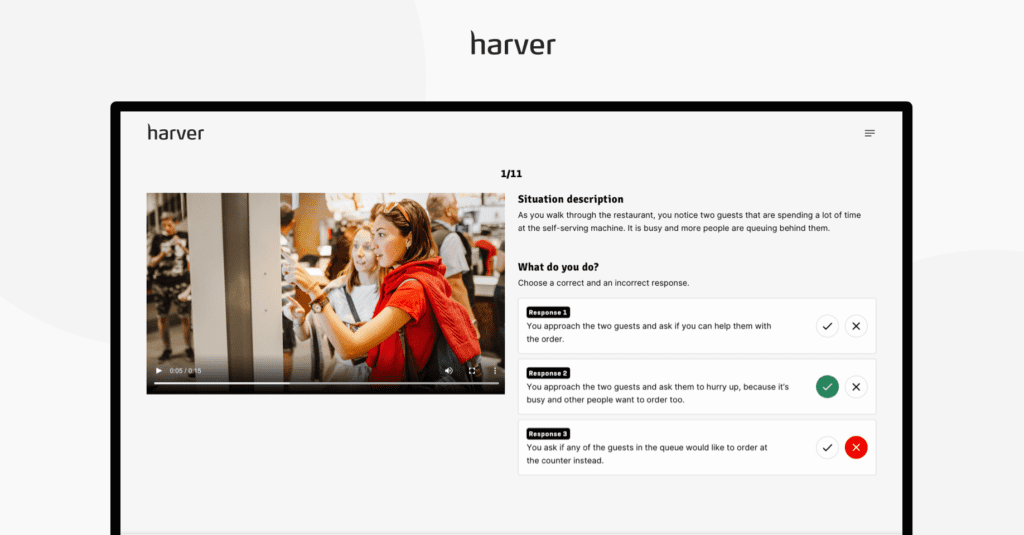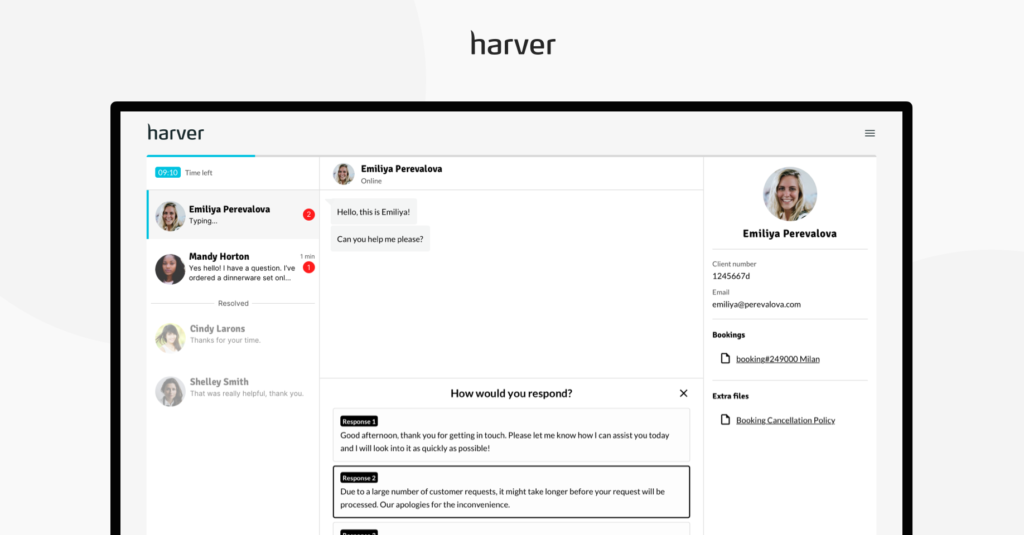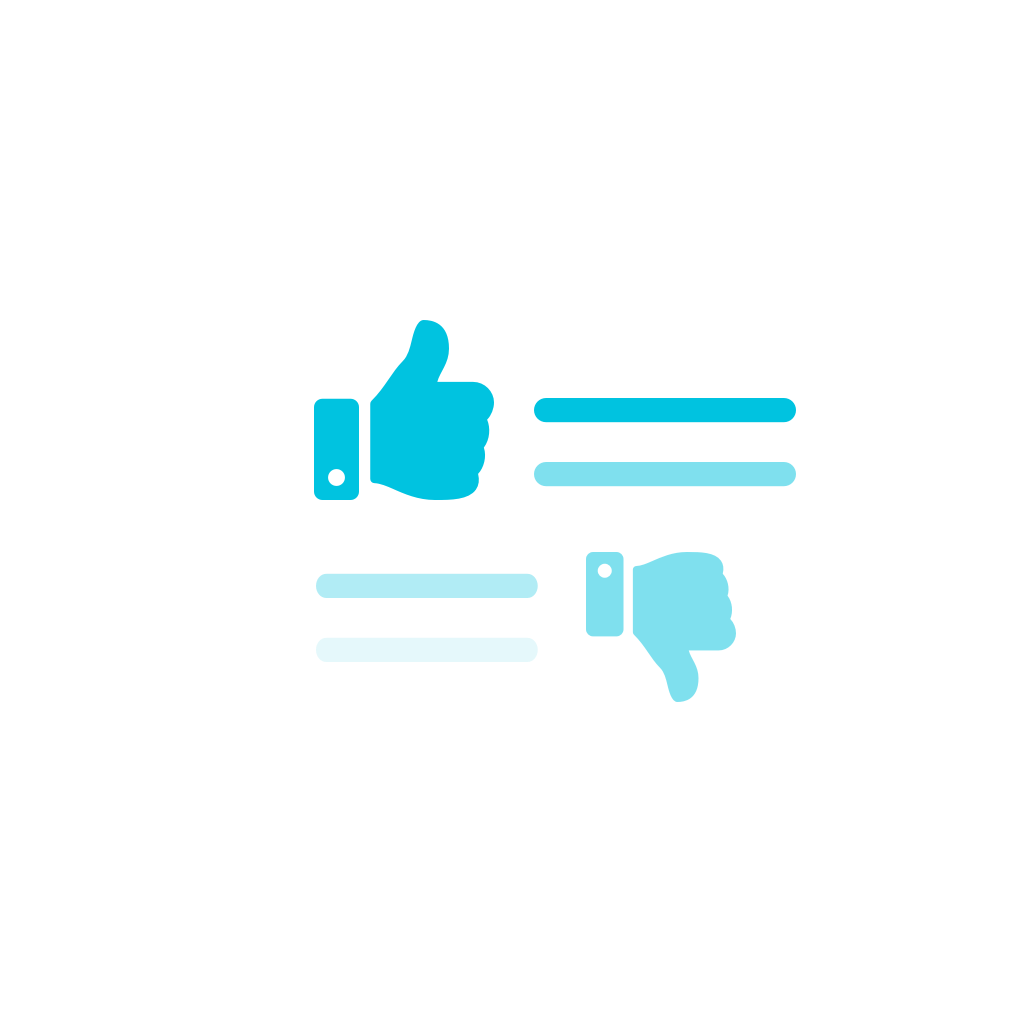Bringing job simulations into your volume hiring process means you can let technology do the heavy lifting when you need to assess candidates efficiently at scale.
Now that the holiday season is approaching and across industries recruiters are looking to hire hundreds and thousands of workers for a multitude of roles simultaneously, you can’t rely on manual processes to find the right people.
Digital job simulations are a reliable form of pre-employment testing that requires almost no effort from the recruiter, and by simulating actual job tasks and scenarios in your assessments, you can quickly identify the best performers for your roles.
So let’s look at the most commonly used types of job simulations, and see how you can implement these into your hiring process.
What’s in?
Like what you see?
Don’t miss out. Subscribe to our quarterly digest to get the latest TA and TM resources delivered right to your inbox.
Why use job simulations in volume hiring?
Job simulations make hiring a better experience for both the hiring manager and the candidate. Here are a few reasons why you should consider using realistic job previews in your volume hiring process.
Speed up the hiring process
In volume hiring, job seekers want a fast process that brings job security quickly. Job simulation tests minimize the number of assessments you need to build a reliable picture of the candidate, so you can speed up the process by focusing on the ones that actually matter.
With virtual job simulations, you’re also able to show large amounts of candidates what the work will be like without having to demonstrate individually to each candidate. This saves vast amounts of time for the recruiter and allows you to progress the candidate to the next stage of the job interview quickly.
If your process is too long, you could lose great candidates to a competitor with a faster process.
Manage candidate expectations
Job simulations give candidates a realistic preview of what they can expect in the day-to-day of the job. Using virtual job role-play helps candidates visualize what the role is really like by giving insights into critical incidents and potential challenges as well as the more enjoyable parts of the job.
We know that in volume hiring, misaligned expectations are one of the main causes of new employee attrition. Industries that use volume hiring also have a higher employee turnover than most.
Call centers, for example, have an average attrition rate of between 30-45% – which is 3x the average in other industries. By including job simulations in your volume hiring process, you can reduce attrition by as much as 63%.
Ensure better-match hires
As many as 87% of employers say they believe some candidates misrepresent themselves on their resumes. Job simulations provide more genuine, reliable insights than a resume or cover letter can offer.
Including real-life simulation exercises in your assessments will also help candidates self-qualify, which is better in the long run for everyone involved. By providing a hands-on taster of the challenges of the job, they will have a much stronger idea of whether they will experience job satisfaction in the role.
It’s a 2-way matching framework that’s as useful to the candidate as it is the recruiter – offer a clearer picture of what the job will be like upfront, and new hires will be likely to stay in the job for longer.
Manage safety concerns
With Covid-19 creating all sorts of new workplace barriers, employers can’t allow candidates on-site to see the work environment for themselves before accepting a job offer.
Virtual job simulations are an effective way to take candidates through realistic job previews of what the day-to-day work looks like without bringing anyone on site.
Eliminate unconscious bias
Job simulations grade candidates entirely on objective criteria that predicts whether they’ll be successful in the job – they don’t take background or employment history into account. This makes work simulations a great tool for eliminating unconscious bias from volume hiring, as hiring decisions are based on data, not a recruiter’s gut feeling.
In this sense, job simulation assessments can be a valuable tool in diversifying the workforce in industries that rely on volume hiring to recruit. Job simulations make the assessment process fair for everyone, regardless of background.
Widen your candidate pool
Similarly, entry-level candidates – which make up a large proportion of the workforce in volume hiring industries – may not have enough experience on their resume to demonstrate their skills but could still be a great fit for the role.
Using job simulations in the hiring process means you can lower entry requirements for positions where there’s a shortage of candidates and still be confident that you’ll find suitable candidates as they’ll be assessed on their proven ability to do the job.
4 types of job simulations ideal for volume hiring
Now that we’ve covered some of the reasons to consider bringing realistic job previews into your volume hiring process, what do these simulations actually look like in practice?
Here are four different types of job simulations to consider.
1. Situational Judgment Tests (SJTs)
Situational judgment tests present candidates with realistic scenarios that they’re likely to be faced with and assess how they behave in response when seeing them for the first time. SJTs offer great insight into how a candidate makes decisions when presented with a critical situation, rather than routine tasks, and are great for giving insights into areas like emotional intelligence, that can be hard to assess.
The candidate is presented with a scenario and is given a list of options that they select what they believe are the best and worst responses they would take when faced with this particular situation.

The technology is then able to rate the candidate based on their answers, but the SJT also gives the candidate a real insight into the kind of situations they’ll be presented with, and be expected to make a judgment on, every day.
This approach is different from the traditional pre-employment testing methods that only evaluate candidates’ skills or personality traits, but don’t provide information about the role, leaving applicants confused, and failing to manage their expectations.
With Harver’s SJTs, for example, you’re taking advantage of our two-way matching framework that shows you not only what skills your applicants have, but also what types of roles they’d fit the best.
Moreover, you can choose between out-the-box situational judgement tests and bespoke SJTs designed by our I/O psychologists to realistically simulate the jobs you’re recruiting for. If you’d like to see some examples and learn more about our assessment solution, you can book a demo below.
2. Virtual job tryouts
Virtual job tryouts are the most effective way of helping candidates visualize themselves in a role. They allow you to assess a number of different skills and competencies in one go, within a real-life setting that mimics the job the candidate will be doing.
For example, Harver offers a Live Chat Support simulation that can be tailored to suit the specifics of any contact center role. Candidates are taken through a realistic job preview where they can get a taste for what the role would be like, while the system assesses their performance in the required skills (for example, typing, problem-solving, multi-tasking, etc.).

Providing them with multiple, staggered customer queries, this pre-employment assessment module allows you to gauge the candidate’s ability to provide an appropriate response.
This kind of job simulation provides the most accurate picture of how a candidate will apply their existing skills and experiences to their new role, and it also gives the candidate a virtual tour of what their working environment will actually be like. If they enjoy their virtual tryout, they can feel confident that they’ll enjoy the job too.
It also gives you a clear indication of how well they understand the role and what will be expected of them, which is key to reducing attrition once the candidate starts the job.
Experience our best-in-class Live Chat Assessment first-hand!
Perfect for remote hiring, our live chat assessment makes it easier than ever to hire live chat agents. Candidates experience the job, while you get actionable data to drive hiring decisions.
3. In-basket exercises
An in-tray or in-basket exercise is a job simulation that focuses on how well a candidate can perform a role-specific exercise within a specific time frame. These tests are a great way of assessing how a candidate will prioritize in roles that are quite demanding.
They offer great insight into how a candidate will plan and multi-task to get a job done within a certain amount of time without getting stressed or overwhelmed.
In customer service roles, it can be difficult to assess skills like project management and organizational skills, and that’s where in-box assessments offer great insight.
4. Role-specific skill assessments
If you’re hiring at scale for a role that requires a specific skill to be successful, you can use role-specific skill assessments in your job simulation to find the most qualified candidates.
Unlike the other job simulation examples above, which assess candidates on multiple skills and qualities at once, you can also create a work sample that laser focuses on a particular skill if this has been highlighted as an essential in the job description.
For example, a typing test, a language test, or a multi-tasking test that mimics actual tasks that the candidate will be performing. Essentially, a job-related skill assessment gives the candidate an insight into the level of skill expected of them in the role.
This allows candidates to self-disqualify from the hiring process early on if they realize their skill isn’t up to the required level, and as an employer you can measure their job performance, benchmarking them against your top performers to see how they fare.
You can see how Harver’s spoken language assessment works and book a demo below.
Next steps
To ensure candidates are happy in their new roles and that they stick around for longer, bring job simulations into your volume hiring process.
Realistic job previews don’t just give you a much more reliable picture of how the candidate will perform on the job, but it gives the candidate an insight into whether they want to work in that particular role too. Recruiting is always a 2-way process, and a job simulation tool will help you learn more about your candidates in less time and with minimum admin effort from your recruiters.
If you’re interested in seeing what Harver’s assessment preview technology can do to help you hire efficiently at scale, you can book a demo below.
Ready to transform your hiring process?




